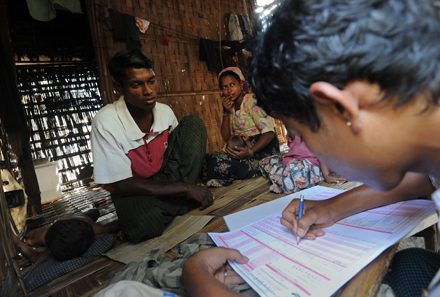Good morning and thank you for the opportunity to be here. The Southeast Asian Human Rights Network is an incredibly important initiative that brings together both advocates and scholars to discuss pressing issues in the region. I think it can set an agenda for future research in terms of the key human rights concerns that affect the region.
In setting this agenda, one of the most important choices that we face is the topics that we choose for scholarship and advocacy. I want to make an argument today for why we need more scholars to choose to study Islam in Myanmar, the gaps that they need to fill and the broader contribution this could make to discussions on the human rights of Muslims in Myanmar.
One reason that the Muslim communities of Myanmar now need to be understood by both the West and by countries in Asia is due to the large scale migration that has taken place. There has been significant irregular migration of Muslims, especially the Rohingya, to parts of South Asia including Bangladesh, Pakistan, India, and even as far as parts of the Middle East, particularly Saudi Arabia, and to Southeast Asia, including Malaysia, Thailand and Indonesia.
Some have made their way as asylum seekers, or as recognised refugees through the United Nations High Commission for Refugees, to Western countries including the United States and Australia. My own experience since 2007 has been with the Burmese community in Melbourne, where there are a handful of Anglo-Burman and Muslim families, who fled Burma in the 1960s and 1970s; 8888 generation activists and their families who came to Australia in the 1990s; Burmese Muslims and other refugees from Karen State who have arrived since 2005; and since 2013, Rohingya asylum seekers who were detained at one of Australia’s off-shore processing centres until their claims for asylum were recognised.
We need to see this diversity inherent in Myanmar’s population, and this includes within the Muslim communities. How do we begin to capture the diversity and richness of Myanmar’s Muslim mosaic? Central to the politics of belonging is how Muslims define themselves. Let me take the 2014 census as an example of how Muslims are seeking to redefine their identity.
International commentary on the census primarily focused on the categories the government would use to mark religion and ethnicity, and specifically whether it would allow individuals to identify as ‘Rohingya’. But there was an absence of coverage of broader Muslim responses to the census. Observers failed to see the fierce discussion and debate within Muslim communities about what categories they wanted to use to define their religious and ethnic status in the census.
Many in the Burmese Muslim community were confused: they did not want to list their ethnicity as ‘Burman’, even if they identified as part Burman. This was because they felt that the ethnic category ‘Burman’ may be conflated by the government with ‘Buddhists’, and therefore overestimated the numbers of Buddhists. On the other hand, as Muslims who take pride in their ‘Burmeseness’ – both in terms of their ancestry as well as the use of Burmese language, clothing and culture – wanted recognition that they belong to Myanmar too.
As a compromise, some leaders from the Burmese Muslim community were advocating for the use of the term ‘Pathi’ Muslim. Here is where history is crucial: this is a term that was used during the period of the kings, and revived in the 1960s, in order to carve out specific recognition for this group. The term Pathi is today used in a broad sense to encompass Muslims of many different ethnic backgrounds in Myanmar, but particularly those with part-Burman ancestry.
From another perspective, some religious leaders from the Indian Muslim community issued a fatwa (Islamic legal opinion) to their community members to instruct them on how to list their identity in the census. They emphasised that Muslims should not be afraid to list their religious identity on the census. Some Indian Muslim leaders even argued that it was haram (forbidden) for a Muslim to fail to list their religion on the census.
Different debates again were held within the minority Shiite community, with some Islamic religious leaders from Yangon advising that they should list themselves as ‘Mogul Shia’ on the census, although some Muslim Shiite leaders from Mandalay disagreed. Like the Burmese Muslim resurrection of the term ‘Pathi’, the use of ‘Mogul Shiite’ was also an attempt to revert back to past categories – in this case the reference to Muslims who had migrated from the Mogul empire – in order to recreate and redefine their future as a community in Myanmar.
This brief insight into broader debates surrounding the 2014 census suggests that scholarship needs to go beyond debates about whether the term ‘Rohingya’ was used (not to diminish the importance of this issue), and recognise the broader discussions around how Muslims want to be identified by the state.
Let me turn now to identify several key themes in academic literature where glaring gaps need to be filled, and misconceptions and bias need to be addressed.The first theme is the history of Muslims in Myanmar.
There are three major phases in scholarship on the history of Islam in Myanmar: Muslims during the time of the Burmese kings; Muslims under colonial rule in Burma; and Muslims during the period of parliament democracy (1948-1962). We catch glimpses in scholarly literature of the important role some Muslim communities played during the time of the kings.Historians have referred in passing to Muslims who served the kings, and the mosques that were established during this period. Yet some historians have effectively written Muslims out of the history of Myanmar. As a scholar recently noted to me, a historian would not be taken seriously today if they wrote a history of the United States that excluded the Jews or the African American community. In the same way, we need to be critical of histories of Burma that have excluded Muslim communities.
The second theme is Muslim political engagement in Myanmar. Some Muslims have been active in the political arena and have made a vital contribution to national politics, yet this has not received sustained attention. Little has been written on the role of Muslims in public life since the 1960s, yet Muslims were politically active in key political moments, such as in 1988 when the Muslim community in Mandalay organised collective demonstrations and protests against the socialist regime. Studies on the positive contribution key Muslims have made to political life could contribute to shifting the current negative discourse that effectively excludes Muslims from national politics.
The third theme is Muslims in times of crisis. The key example here is research on the Rohingya that raises crucial issues of citizenship, statelessness, and irregular migration, although there is a need for rigorous academic engagement to inform advocacy efforts (such as the work of Nausheen Anwar).
Another example is the perceived sense of crisis in relation to inter-religious marriage and the position of Burmese Buddhist women. The literature on ‘women’ in Myanmar is narrow as it has generally focused on Burman and/or Buddhist women, or at least ‘non-Muslim’ women. It has been assumed that inter-religious marriage primarily takes place between a Burmese woman and a Muslim man, which even if this was the case in the past is not necessarily the case today. We need scholars who can contextualise today’s debate on inter-religious marriage. For example, the 1954 law the allowed women to divorce their Muslim husband was actually introduced by Minister for Justice U Khin Maung Latt, who was Muslim, in response to the social need to allow Burmese women (who had been married to Indian Muslim men who were forced to flee Burma) to dissolve their marriage because of the difficulties women face obtaining a divorce under Islamic law. Yet there is no evidence of such a social crisis today, and such perspectives need to challenge the stereotypes that dominate contemporary debates.
The fourth theme is the practise of Islam among the Muslim communities of Myanmar. Most Muslims in Myanmar are Sunni Muslims of the Hanafi school of law, although some follow the Shafi school of law. Muslims therefore have more in common with communities in South Asia, compared to Muslim communities in Southeast Asia. There are almost no studies to date on the beliefs and practises of these Muslim groups. This is despite the fact that Islamic personal law is recognised by the state and that Muslims can go to the court to have family matters decided in accordance with this law. We must not dismiss Islamic law in Myanmar as ‘artificial’, but rather seriously consider what it means for Muslims today.
To conclude, the Muslims of Myanmar clearly constitute an understudied area of research for Burma Studies, Islamic Studies and Asian Studies more broadly. I want to suggest that future scholarship in this area must do two things in particular.
First, we need to displace Buddhism from its privileged place in the field of Burma Studies. There is a clear disconnect between the way we view Islam and Buddhism. Buddhism, I would suggest, has been protected, idealised and shielded from scholarly criticism for too long. I am not suggesting that Buddhism is not an important part of the study of Myanmar. On the contrary, just as Islam is critical to understanding the Indonesian local context, or Catholicism is vital to the study of the Philippines, Buddhism is clearly a central part of the study of Myanmar.
Yet we must be willing to reject the rose-tinted glasses with which the West often views Buddhism, in contrast to the perception of Islam as a violent religion. We must reject perpetuating the stereotype that Islam is inherently ‘bad’ and ‘violent’ and that in contrast Buddhism is ‘peaceful’, ‘non-violent’, and ‘good’. We must recognise that the tendency for violence can arise in any religion, including among those who identify with Buddhism or who seek to use Buddhism as a convenient rallying point. The evidence we have suggests that it is Buddhists who are the main cause of violence against Muslims in Myanmar.
The second aspect is related more broadly to the study of Islam in Asia. For too long Muslims in Myanmar have been overlooked, ignored and forgotten in discussions and debates on Islam in both South Asia and Southeast Asia. We must stop acting as if Islam in Myanmar is peripheral and irrelevant, or an anomaly that does not really fit. Rather, we must begin to see the potential for the study of Muslim communities in Myanmar to offer fresh insights and generate new knowledge, as something of a ‘crossroads’ for Islam between South Asia and Southeast Asia.
The opportunity is there for scholars from a wide range of disciplines to begin undertaking this task. There is a need for historians who are willing to do the hard work of reconsidering historical sources and where possible discovering new ones. There is a need for ethnographers and anthropologists to spend time in the field to get to know these Muslim communities in order to construct rich ethnographies of contemporary community dynamics. There is a need for religious studies and Islamic studies scholars to take the study of Islam in Myanmar seriously.
I could go on. The point I want to make is this: there is a need for an informed and scholarly response to contemporary issues facing the Muslim communities of Myanmar. Scholars can play a vital role in informing these human rights issues by addressing some of the obvious bias and gaps in existing literature. I hope some of you make take up this challenge.
Melissa Crouch is a Research Fellow at the Centre for Asian Legal Studies, NUS. In December 2014 she is moving to the Law Faculty, the University of New South Wales, Sydney. This speech is adapted from an edited book on Islam and the State in Myanmar: Muslim-Buddhist Relations and the Politics of Belonging (forthcoming 2015).
Note: This talk was given at the Southeast Asian Human Rights Network Conference on 15-16 October 2014 in Kuala Lumpur, Malaysia. One of the co-panelists, Pak Ulil Abshar Abdullah who is well-known as a proponent of liberal Islam, was banned from entering Malaysia, but was able to give his presentation via skype. On the same day, the Malaysian Bar Council conducted a peaceful protest in support of law professor Azmi Sharom (one of the organisers of the conference), to protest against the sedition charges he faces. A video recording of the session will appear on Libertv shortly.
 Facebook
Facebook  Twitter
Twitter  Soundcloud
Soundcloud  Youtube
Youtube  Rss
Rss 